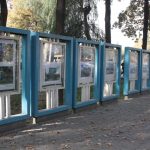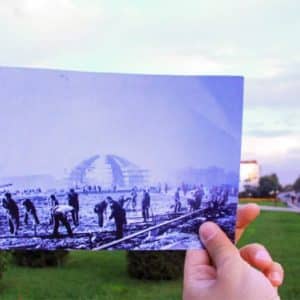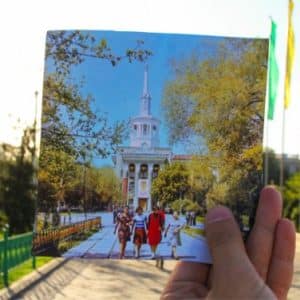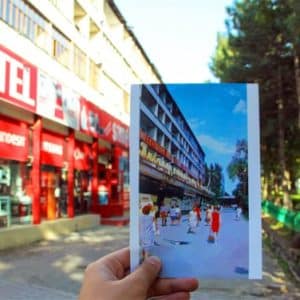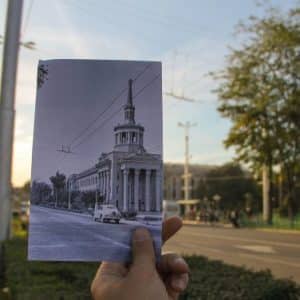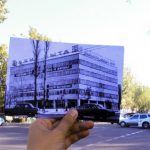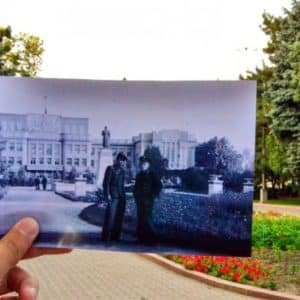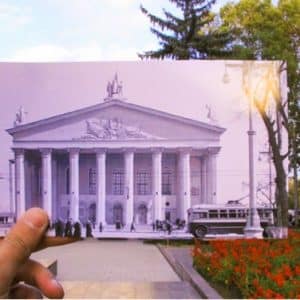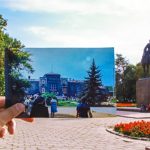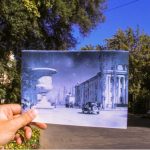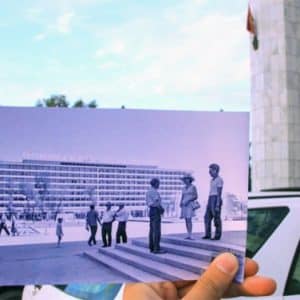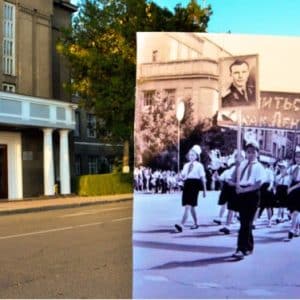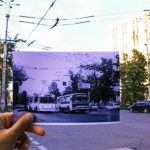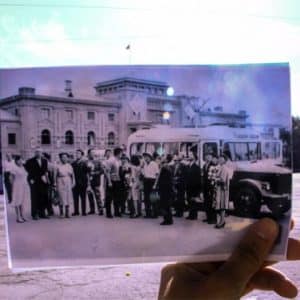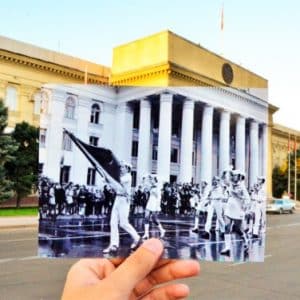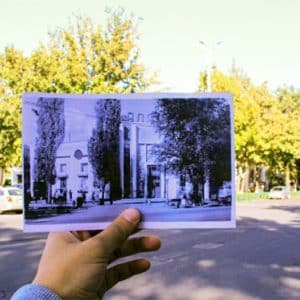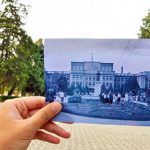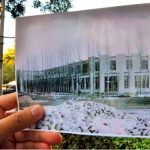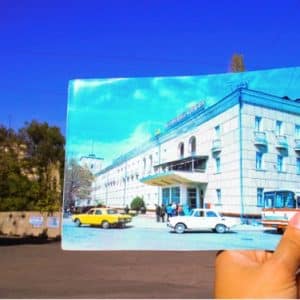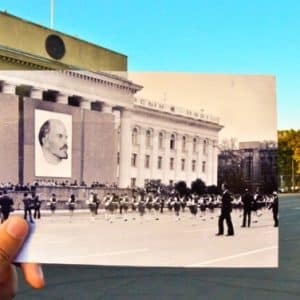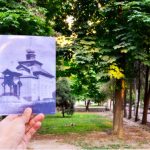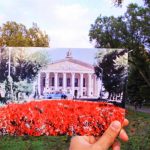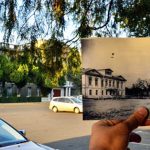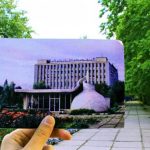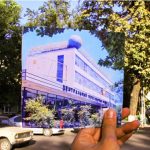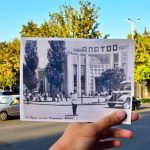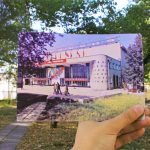In photography, superimposition is the placement of one image over another, either to conceal something or create an overall effect. The concept was widely developed by Russian photographer Sergey Larenkov, who compared the past and present of multiple cities in reference to World War II. He describes theses superimposed archival photos as “ghosts.” A new outdoor exhibition of photography near Ala-Too Square in central Bishkek, Kyrgyzstan uses superimposition in much the same way.
The project “Bishkek: Yesterday and Today” was begun by Marat Mashanlo, a young man with an interest in archival photography. After perusing the archival collections of Bishkek at Diesel Forum and Foto.kg, he decided to photograph a number of old photographs on location, creating a visual comparison of the past and present.
The style of photography is spontaneous and unpolished. In most of the photos, the photographer’s hand can be seen holding the contrasting image, which has an engaging quality. The hand extends from an unknown individual, which breaks the boundary between the photograph and the viewer. This perspective invites the viewer to become the holder of the photograph, thus a part of the photograph’s world.
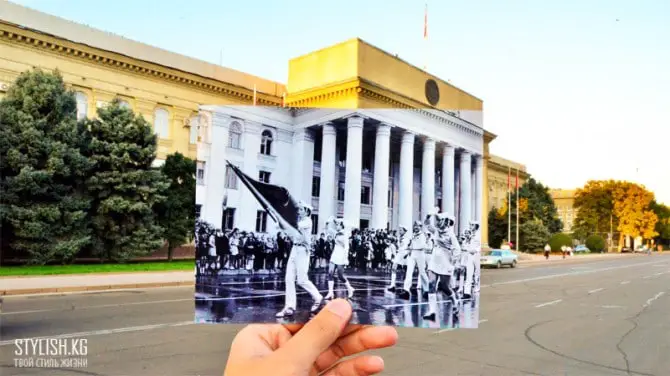
The most prominent effect is the establishment of the past and present. Differences between the images of the past and present are evident in the style of cars and dress of people, the occasional presence of Lenin’s image, and the presence of soldiers. The architecture, though, has not changed. In this way, the photos are striking. When I showed photographs from this exhibition to a young cosmetician working in central Bishkek’s Istanbul Salon, her first response was, “Everything looks the same.” When I asked her what she thought the exhibition was about, she said, “Beauty. Simple beauty.”
The photographs can be perceived in a number of ways in Kyrgyzstan, depending on your age. All of the young people I approached with these photographs described the photos as “beautiful” and “cool.” Older people had a much less impressed reaction. When I asked a Russian-language teacher why that was, she said it was because these photos are not art, but history. She added that, “when the younger generation looks at the photos, it doesn’t see the same world as the older generation, which remembers Soviet times and feels a kind of nostalgia.” One gentleman, who works as a security guard at the U.S. Embassy, described to me how he studied engineering at university just up until the independence of Kyrgyzstan. Once he graduated though, the economy changed, forcing him to find work in a different field. He asked me if I could ever have known such a hard time in my life. Then he looked at the photos and simply said, “Sometimes I wish we could go back to those times.”
On display at the exhibit is a letter to the citizens of Bishkek from the photographer, Mashanlo. He describes his intent to show the people the “immortal soul of Bishkek.” He boasts the perpetual need for cleanliness, kindness, and structure within the city. Bishkek was founded 135 years ago. Mashanlo describes the legacy of Bishkek as “only a moment in history,” but the future is still to come and “in our hands.” In this way, the project was not meant to be a history lesson, but a way to inspire people to be active in their city. His words are powerful and supported by the government. The young Parliament Deputy, Dastan Beshekev, came across Mashanlo’s photography on Facebook. He explains on his website that on the one hand, he did not like the photos, but on the other hand, he knew their historical significance. He approached the non-profit organization “Foundation for Support of a New Generation,” which supports educational initiatives. They offered their public stands for the use of the exhibition.
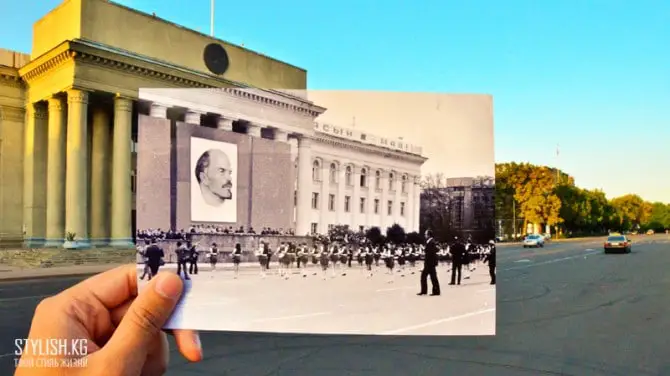
The photographs Mashanlo used for this project disclose a unique problem within Kyrgyzstan. There is no national archive, something which would be akin to the Library of Congress in the United States. The storage of glass plates, paper photographs, slides, and negatives has been spread across various government agencies, museums, libraries, and private archives. Access has been difficult and the storage, at times, unsatisfactory. Diesel Forum is an Internet forum for the entire country, including discussion on a number of subjects. The present collection of archival photography of Kyrgyzstan and its cities available through this forum is primarily rooted in the personal choice of individuals to scan in their personal collections. The photo agency, Foto.kg, is committed to gathering, organizing, restoring, preserving, and properly storing such archival photography on a more extensive scale, in hopes of preserving a history that often feels fragile, unknown, and manipulated. The ultimate goal is to have a physical location for tours and research.
For now, Mashanlo’s photo exhibit “Bishkek: Yesterday and Today” provides access to archival photography placed in a contemporary context. Art, history, or nostalgia, the project is unique for Kyrgyzstan and is not to be missed.
Photos provided by stylish.kg


